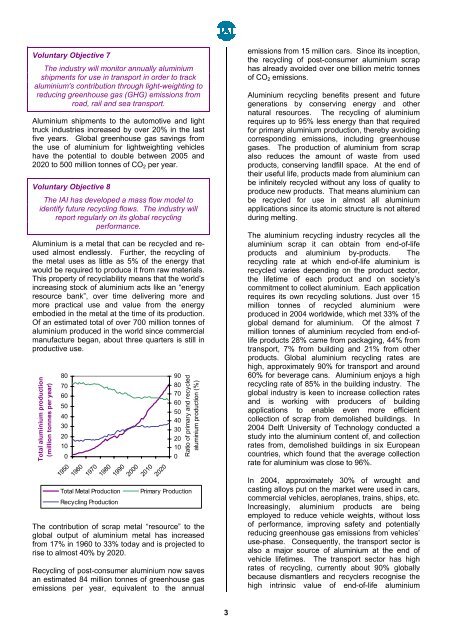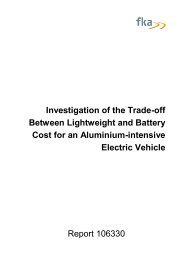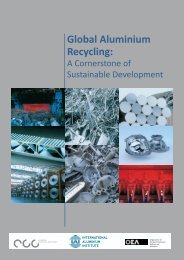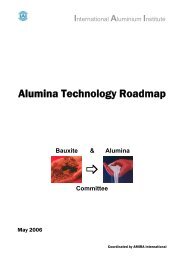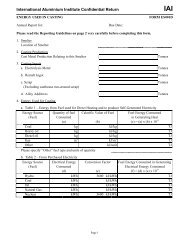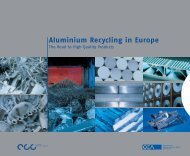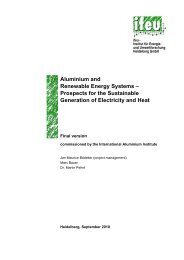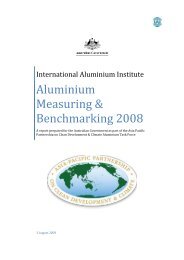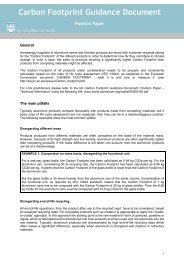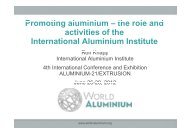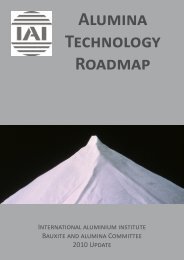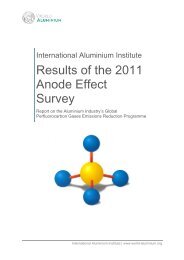aluminium for future generations sustainability update 2005
aluminium for future generations sustainability update 2005
aluminium for future generations sustainability update 2005
You also want an ePaper? Increase the reach of your titles
YUMPU automatically turns print PDFs into web optimized ePapers that Google loves.
Voluntary Objective 7<br />
The industry will monitor annually <strong>aluminium</strong><br />
shipments <strong>for</strong> use in transport in order to track<br />
<strong>aluminium</strong>'s contribution through light-weighting to<br />
reducing greenhouse gas (GHG) emissions from<br />
road, rail and sea transport.<br />
Aluminium shipments to the automotive and light<br />
truck industries increased by over 20% in the last<br />
five years. Global greenhouse gas savings from<br />
the use of <strong>aluminium</strong> <strong>for</strong> lightweighting vehicles<br />
have the potential to double between <strong>2005</strong> and<br />
2020 to 500 million tonnes of CO 2 per year.<br />
Voluntary Objective 8<br />
The IAI has developed a mass flow model to<br />
identify <strong>future</strong> recycling flows. The industry will<br />
report regularly on its global recycling<br />
per<strong>for</strong>mance.<br />
Aluminium is a metal that can be recycled and reused<br />
almost endlessly. Further, the recycling of<br />
the metal uses as little as 5% of the energy that<br />
would be required to produce it from raw materials.<br />
This property of recyclability means that the world’s<br />
increasing stock of <strong>aluminium</strong> acts like an “energy<br />
resource bank”, over time delivering more and<br />
more practical use and value from the energy<br />
embodied in the metal at the time of its production.<br />
Of an estimated total of over 700 million tonnes of<br />
<strong>aluminium</strong> produced in the world since commercial<br />
manufacture began, about three quarters is still in<br />
productive use.<br />
Total <strong>aluminium</strong> production<br />
(million tonnes per year)<br />
80<br />
70<br />
60<br />
50<br />
40<br />
30<br />
20<br />
10<br />
0<br />
Total Metal Production<br />
Recycling Production<br />
1950<br />
1960<br />
1970<br />
1980<br />
1990<br />
2000<br />
2010<br />
2020<br />
90<br />
80<br />
70<br />
60<br />
50<br />
40<br />
30<br />
20<br />
10<br />
0<br />
Ratio of primary and recycled<br />
<strong>aluminium</strong> production (%)<br />
Primary Production<br />
The contribution of scrap metal “resource” to the<br />
global output of <strong>aluminium</strong> metal has increased<br />
from 17% in 1960 to 33% today and is projected to<br />
rise to almost 40% by 2020.<br />
Recycling of post-consumer <strong>aluminium</strong> now saves<br />
an estimated 84 million tonnes of greenhouse gas<br />
emissions per year, equivalent to the annual<br />
emissions from 15 million cars. Since its inception,<br />
the recycling of post-consumer <strong>aluminium</strong> scrap<br />
has already avoided over one billion metric tonnes<br />
of CO 2 emissions.<br />
Aluminium recycling benefits present and <strong>future</strong><br />
<strong>generations</strong> by conserving energy and other<br />
natural resources. The recycling of <strong>aluminium</strong><br />
requires up to 95% less energy than that required<br />
<strong>for</strong> primary <strong>aluminium</strong> production, thereby avoiding<br />
corresponding emissions, including greenhouse<br />
gases. The production of <strong>aluminium</strong> from scrap<br />
also reduces the amount of waste from used<br />
products, conserving landfill space. At the end of<br />
their useful life, products made from <strong>aluminium</strong> can<br />
be infinitely recycled without any loss of quality to<br />
produce new products. That means <strong>aluminium</strong> can<br />
be recycled <strong>for</strong> use in almost all <strong>aluminium</strong><br />
applications since its atomic structure is not altered<br />
during melting.<br />
The <strong>aluminium</strong> recycling industry recycles all the<br />
<strong>aluminium</strong> scrap it can obtain from end-of-life<br />
products and <strong>aluminium</strong> by-products. The<br />
recycling rate at which end-of-life <strong>aluminium</strong> is<br />
recycled varies depending on the product sector,<br />
the lifetime of each product and on society’s<br />
commitment to collect <strong>aluminium</strong>. Each application<br />
requires its own recycling solutions. Just over 15<br />
million tonnes of recycled <strong>aluminium</strong> were<br />
produced in 2004 worldwide, which met 33% of the<br />
global demand <strong>for</strong> <strong>aluminium</strong>. Of the almost 7<br />
million tonnes of <strong>aluminium</strong> recycled from end-oflife<br />
products 28% came from packaging, 44% from<br />
transport, 7% from building and 21% from other<br />
products. Global <strong>aluminium</strong> recycling rates are<br />
high, approximately 90% <strong>for</strong> transport and around<br />
60% <strong>for</strong> beverage cans. Aluminium enjoys a high<br />
recycling rate of 85% in the building industry. The<br />
global industry is keen to increase collection rates<br />
and is working with producers of building<br />
applications to enable even more efficient<br />
collection of scrap from demolished buildings. In<br />
2004 Delft University of Technology conducted a<br />
study into the <strong>aluminium</strong> content of, and collection<br />
rates from, demolished buildings in six European<br />
countries, which found that the average collection<br />
rate <strong>for</strong> <strong>aluminium</strong> was close to 96%.<br />
In 2004, approximately 30% of wrought and<br />
casting alloys put on the market were used in cars,<br />
commercial vehicles, aeroplanes, trains, ships, etc.<br />
Increasingly, <strong>aluminium</strong> products are being<br />
employed to reduce vehicle weights, without loss<br />
of per<strong>for</strong>mance, improving safety and potentially<br />
reducing greenhouse gas emissions from vehicles’<br />
use-phase. Consequently, the transport sector is<br />
also a major source of <strong>aluminium</strong> at the end of<br />
vehicle lifetimes. The transport sector has high<br />
rates of recycling, currently about 90% globally<br />
because dismantlers and recyclers recognise the<br />
high intrinsic value of end-of-life <strong>aluminium</strong><br />
3


